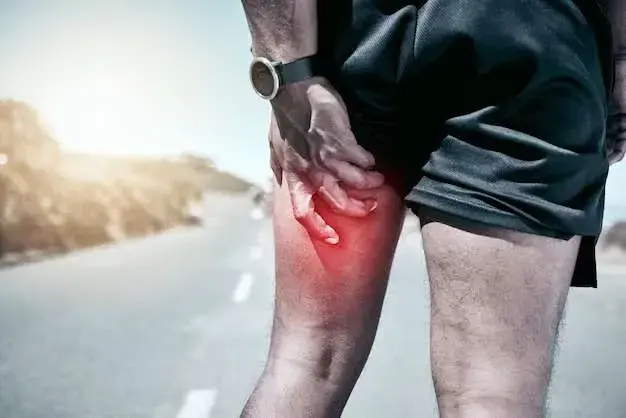Three muscles make up the Hamstring, which runs through the back of the leg from your hip joint to just below the knee. Without these muscles, you couldn't bend your knee or stretch your leg straight behind your body. So, they are crucial to your ability to move.
Physically active people know that mobility is compromised and comfort is at risk when the Hamstring is strained. Many of the patients we treat for hamstring strains are pursuing athletic goals, so it's critical for their training and performance that they recover quickly.
Athletes are more likely to suffer even if anyone can tear a hamstring.
In this article, Let's examine the symptoms, causes, and how to heal hamstring strain fast, so please continue reading to learn more.
Also, Read Sprain vs Strain Ankle: All You Need to Know
 On the back of your thigh, three muscles make up this group. You can flex your knee due to them.
A few of these muscles become overworked when the hamstrings are strained. Even muscle tearing could occur. Activities that require a lot of sprinting, jumping, or abrupt stopping and resuming are prone to cause a hamstring strain.
A hamstring strain is additionally more probable if:
On the back of your thigh, three muscles make up this group. You can flex your knee due to them.
A few of these muscles become overworked when the hamstrings are strained. Even muscle tearing could occur. Activities that require a lot of sprinting, jumping, or abrupt stopping and resuming are prone to cause a hamstring strain.
A hamstring strain is additionally more probable if:
What is a hamstring?
 On the back of your thigh, three muscles make up this group. You can flex your knee due to them.
A few of these muscles become overworked when the hamstrings are strained. Even muscle tearing could occur. Activities that require a lot of sprinting, jumping, or abrupt stopping and resuming are prone to cause a hamstring strain.
A hamstring strain is additionally more probable if:
On the back of your thigh, three muscles make up this group. You can flex your knee due to them.
A few of these muscles become overworked when the hamstrings are strained. Even muscle tearing could occur. Activities that require a lot of sprinting, jumping, or abrupt stopping and resuming are prone to cause a hamstring strain.
A hamstring strain is additionally more probable if:
- No warm-up is done before working out.
- Your quadriceps, which pull your hips forward and hamstrings into a tightening position, are tense.
- Tight glutes. The hamstrings and glutes cooperate. Hamstrings may be overworked and strained if the glutes are weak.
What are the symptoms of Hamstring?
A hamstring strain can cause several pains, including:- Intense thigh discomfort toward the back
- Radiating pain that never stops in the back of the thigh
- Reduction in range of motion
- Leg swelling behind the thigh
- Tenderness in the thigh's back
What are the grades of the hamstring strain?
Grades of a hamstring strain. Hamstring injuries are divided into three grades based on their seriousness.1. Grade 1 hamstring strain
Sometimes known as a pulled hamstring, it is a minor strain. It occurs when the hamstring muscles overextend themselves without rupturing. The ailment is a tear if the Hamstring is torn due to excessive stretching. Grades for hamstring tears include:2. Grade 2 hamstring strain
A partial muscle tear is a grade 2 hamstring strain. This indicates that the muscle hasn't ruptured. A grade 2 rip hurts more than a grade 1 strain does. You'll probably limp and feel like your leg is weak.3. Grade 3 hamstring strain
A grade 3 hamstring injury is the worst kind of hamstring tear. It happens if the hamstring muscle separates from the bone or tears off. Avulsion describes a tear that causes the muscle to separate from the bone. When you suffered a grade 3 tear, you most likely felt or heard a "popping" sound. Additionally, your thigh's back will be incredibly uncomfortable and swollen. You might be unable to bear weight on the hurt leg due to how bad the tear is. Also, read about Athlete's Foot Meaning & Warts Meaning.How can you heal a hamstring strain fast?
Healing a hamstring strain requires time and appropriate care. While there is no magic formula for instant recovery, here are some steps you can take to aid in the healing process and potentially speed up recovery:1. Rest -
As with any injury, you'll need to immediately relieve pressure on the wound as soon as possible. You have a muscular injury when you have a strain; thus, stretching and tightening the affected muscles will only worsen the hamstring pain. Lift the injured leg and recline while watching a wonderful movie. The swelling can be reduced when blood, along with inflammatory factors, drains out of the area by raising the leg nearer to or even above the level of the heart. Therefore, the first thing to do the next time you have pain, especially a hamstring strain, is to get off the feet as soon as possible. You might avoid doing it for days or even weeks.2. Stretching -
After the pain and swelling have reduced, starting a gentle stretching exercise after 3-4 days is usually safe. The muscle will recover strongly but much more tightly than before when the minor muscle fiber tears heal. Tight muscles increase the likelihood of a muscle being strained again since a strain is an overstretching of the muscle. We are reducing our risk of injuring the strain during the healing period by gently stretching. Stretching can be increased to a more expanded degree when the injury heals, but it's crucial to slow down if you experience any pain or recurrence of weakness.3. Ice therapy -
Sometimes, muscle inflammation prevents repair cells from working quickly and effectively. By limiting blood flow to the affected area, applying ice to a fresh injury lowers inflammation. Reduced inflammation results from decreased blood flow. Ice also lessens pain in the wounded area, which is a bonus. Ice can be applied locally or all over the body to treat pain and inflammation. When you get out of the water, the cold water forces more blood to the extremities, speeding up recovery.4. Compression -
Wearing sleeves or other clothing that is too small for you or is largely made of spandex is known as compression. They are frequently used by professional sportsmen while playing, but they can also be helpful for recovery. The key to strain healing is rapidly increasing the blood flow of repair cells and nutrients to the injured site.5. Massage -
The benefits of massages for physical well-being, stress reduction, and relaxation are well known. However, massages have uses beyond just releasing knots. It has been demonstrated that massage increases lymph and blood flow to the extremities, which can aid and even hasten the healing process. The soreness, spasms, and cramps that typically accompany hamstring strains can also be relieved by massage.6. Topical Painkillers -
Several tools are also available if you want a slightly less active pain and inflammation management method. You might heal more quickly if you take pain-killing tablets to manage the injury and topical lotions and gels for pain relief. Methyl salicylate is a substance that is commonly found in pain-relieving lotions. This is because it addresses the problem from two angles by simultaneously lowering inflammation and providing a counterirritant. Using gels with this component can help you relieve pain by reducing inflammation.7. Diet -
Coenzyme Q10 and turmeric derivatives can be found in many foods and supplements, and they can both be quite helpful in easing inflammation and pain to facilitate hamstring repair. Furthermore, eating a balanced diet that avoids foods heavy in fat and other inflammatory ingredients and concentrates on vitamins and minerals will boost your body's natural healing process. Also, Read What Is A Muscle Strain? Know Its Causes & TreatmentHow to avoid getting a hamstring strain?
Maintaining healthy and strong muscles is the best way to prevent injury because a strained hamstring directly results from a torn muscle. Some excellent tips for preventing hamstring injuries include:- Before any rigorous activity, fully warm up.
- For strength and flexibility, consistently engage in physical activity and stretching.
- Never overdo it; be aware of your limits, and gradually increase the intensity of your workouts to keep your body safe.
- Recognize discomfort and put an end to what you're doing.
- Before engaging in vigorous activity, let your body recuperate.
- Make careful to work out safely and correctly.
- Give yourself adequate time to train to participate in an event.
Also, read about Acupressure Points For Back Pain.
Conclusion -
Strains can be painful and difficult, but they usually aren't cause for alarm. One of the most frequent injuries among athletes in any activity is muscle strain, and there are several at-home treatments you can try to recover from one. A hamstring can happen to anyone. However, there is a higher danger for those participating in rapid-running sports like basketball, football, and soccer. So you can always treat the hamstring strain at home and try the treatments mentioned above to heal it; if it persists, you can visit our doctor for a speedy recovery.
Tagged in
Exercise

Reviewed by







